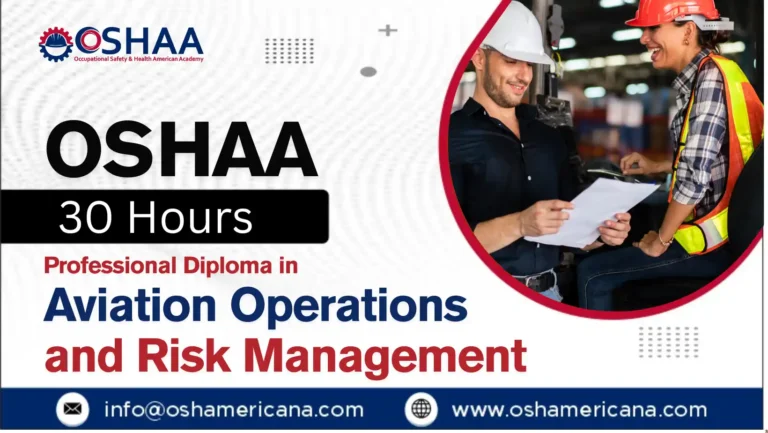The OSHAA 30 Hour Professional Diploma in Airport, Airline and Aviation Safety is a globally recognized qualification designed to prepare learners for critical roles in ensuring safety, compliance, and operational excellence across the aviation sector. Covering airports, airlines, and general aviation operations, this program provides a comprehensive foundation for professionals seeking to strengthen their expertise in aviation safety management.
Delivered through a structured 30‑hour curriculum, the diploma explores essential areas such as Safety Management Systems (SMS), OSHAA standards, hazard identification, risk assessment, occupational health and safety, ground handling, flight operations safety, passenger protection, and emergency response planning. Learners also gain insights into ICAO and IATA frameworks, ensuring their training aligns with international aviation benchmarks.
This program is ideal for aviation staff, safety officers, compliance specialists, ground handling personnel, cabin crew supervisors, and students who want to enhance their professional profile with a recognized qualification. By combining theory with real‑world applications, participants develop the ability to identify risks, implement safety protocols, and contribute to a strong safety culture across airports and airlines.
Graduates of this diploma are well‑prepared for roles such as Aviation Safety Officer, Compliance Specialist, Airport Operations Supervisor, or Emergency Response Coordinator. The qualification also serves as a stepping stone toward advanced diplomas, bachelor’s, or master’s programs in aviation safety and management.
In an industry where safety is non‑negotiable, the OSHAA 30 Hour Professional Diploma in Airport, Airline and Aviation Safety empowers learners to become trusted professionals capable of safeguarding passengers, crew, and operations in line with global standards.
OSHAA 30 Hour Professional Diploma in Airport, Airline and Aviation Safety
Study Units
Learning Outcomes
1. Introduction to Aviation, Airline & Airport Safety Standards
- Explain the importance of safety as the foundation of aviation operations
- Identify the roles of ICAO, IATA, and OSHAA in shaping safety frameworks
- Understand the relationship between global standards and local regulations
- Describe the evolution of aviation safety practices and milestones
- Differentiate between proactive and reactive safety approaches
- Recognize the role of safety culture in aviation organizations
- Assess how international standards influence airline and airport operations
- Relate aviation safety practices to global benchmarks
2. Aviation Safety Management Systems (SMS)
- Define the structure and purpose of SMS in aviation
- Apply hazard identification and risk assessment techniques
- Understand safety performance indicators and monitoring processes
- Recognize the role of reporting systems in SMS
- Evaluate the effectiveness of safety assurance processes
- Apply continuous improvement principles in safety management
- Understand operator responsibilities in SMS implementation
- Develop strategies for integrating SMS into daily operations
3. Flight Operations Safety & Risk Management
- Identify hazards associated with flight operations
- Apply risk management principles to flight planning and execution
- Understand the role of flight data monitoring in safety
- Recognize the impact of weather, ATC, and technical reliability
- Apply procedures for safe takeoff, en-route, and landing operations
- Evaluate the impact of human error on flight safety
- Develop strategies to minimize operational risks
- Understand the role of pilots and dispatchers in maintaining safety
4. Ground Handling & Airside Safety
- Identify hazards in ground handling and airside operations
- Apply safety protocols for ramp, taxiway, and apron areas
- Understand safe aircraft turnaround and marshalling procedures
- Recognize the importance of Foreign Object Debris (FOD) prevention
- Apply safety standards for baggage and cargo handling
- Evaluate risks in fueling, towing, and maintenance activities
- Understand coordination between ground staff and ATC
- Develop strategies to minimize airside incidents
5. Cabin Crew Safety & Passenger Protection
- Recognize the role of cabin crew in ensuring passenger safety
- Apply safety protocols during boarding, in-flight, and disembarkation
- Understand emergency equipment use and evacuation procedures
- Manage passenger behavior and handle disruptive situations
- Apply first aid and medical emergency procedures
- Ensure compliance with international passenger safety regulations
- Promote cultural sensitivity and accessibility for diverse passengers
- Develop strategies to enhance passenger protection and trust
6. Occupational Health & Safety in Aviation
- Apply OSHAA workplace safety standards in aviation environments
- Identify occupational hazards for flight and ground staff
- Understand ergonomics and fatigue management in aviation roles
- Apply fire, electrical, and chemical safety protocols
- Recognize the importance of personal protective equipment (PPE)
- Conduct workplace safety inspections and audits
- Promote staff well-being and occupational health awareness
- Evaluate the impact of occupational safety on performance
7. Aviation Security & International Regulatory Compliance
- Understand ICAO Annex 17 and its application to aviation security
- Identify key security threats to airlines, airports, and passengers
- Apply passenger, baggage, and cargo screening procedures
- Recognize the role of national and international security agencies
- Implement access control and perimeter security measures
- Develop emergency response strategies for security incidents
- Ensure compliance with international aviation security regulations
- Evaluate the effectiveness of aviation security systems
8. Emergency Response & Crisis Management in Aviation
- Understand the principles of aviation emergency planning
- Apply procedures for fire, medical, and evacuation emergencies
- Recognize the importance of crisis communication
- Develop coordination strategies with emergency services
- Conduct drills and simulations for preparedness
- Apply risk assessment to emergency planning
- Understand staff roles in crisis response
- Evaluate the effectiveness of emergency management systems
9. Human Factors, Crew Resource Management & Fatigue Control
- Understand the impact of human factors on aviation safety
- Apply Crew Resource Management (CRM) principles in operations
- Recognize the importance of teamwork and communication
- Develop strategies to manage fatigue and workload
- Understand decision-making processes under stress
- Apply conflict resolution techniques in crew environments
- Promote accountability and shared responsibility
- Evaluate CRM effectiveness in reducing human error
10. Environmental Safety & Sustainability in Aviation
- Understand environmental challenges in aviation operations
- Apply principles of sustainable aviation development
- Recognize the importance of carbon reduction initiatives
- Implement fuel efficiency and eco-friendly practices
- Evaluate noise management and pollution control measures
- Understand ICAO’s environmental sustainability frameworks
- Promote green initiatives within aviation organizations
- Assess long-term benefits of sustainability in aviation
Course Benefits – OSHAA 30 Hour Professional Diploma in Airport, Airline and Aviation Safety
Globally Recognized Qualification
- Earn a diploma aligned with OSHAA, ICAO, and IATA standards
- Gain credibility valued by airlines, airports, and aviation authorities worldwide
- Strengthen your professional profile with an internationally benchmarked credential
- Demonstrate compliance with global aviation safety frameworks
- Build trust with employers by showcasing standardized training
- Position yourself competitively in both domestic and international aviation markets
- Add a professional credential that signals excellence and reliability
- Enhance your resume with a qualification recognized across the aviation sector
Comprehensive Safety Skill Development
- Acquire knowledge of airport, airline, and aviation operations
- Develop expertise in hazard identification and risk assessment
- Learn how to implement and monitor Safety Management Systems (SMS)
- Gain practical skills in emergency response and crisis management
- Understand occupational health and safety requirements in aviation
- Build competence in passenger safety and customer protection
- Learn to integrate sustainability into aviation safety practices
- Develop a balanced skill set covering technical, operational, and compliance areas
Career Advancement Opportunities
- Qualify for roles such as Aviation Safety Officer, Compliance Specialist, or Emergency Response Coordinator
- Gain a competitive edge for promotions and leadership positions in aviation safety
- Strengthen eligibility for international aviation career opportunities
- Build a foundation for progression into advanced diplomas, bachelor’s, or master’s programs
- Enhance your professional credibility for supervisory and management roles
- Position yourself as a future-ready aviation professional
- Increase employability in both public and private aviation organizations
- Open pathways to consultancy and advisory roles in aviation safety
Enhanced Safety and Compliance Competence
- Master the application of OSHAA standards in aviation environments
- Learn to identify, assess, and mitigate workplace hazards
- Gain expertise in regulatory compliance and international safety laws
- Develop the ability to conduct safety audits and inspections
- Understand the role of safety culture in reducing risks
- Strengthen knowledge of risk management and emergency preparedness
- Apply best practices in occupational health and safety
- Become a valuable asset by ensuring safe and compliant operations
Leadership and Communication Skills
- Build strong team leadership and management abilities
- Learn effective cross-cultural communication in safety-critical environments
- Develop conflict resolution and negotiation skills
- Strengthen decision-making under pressure
- Promote a proactive safety culture within aviation organizations
- Gain confidence in motivating and guiding diverse teams
- Understand the importance of ethical leadership in aviation safety
- Enhance collaboration and networking skills across aviation stakeholders
Sustainability and Future-Readiness
- Understand environmental safety challenges in aviation operations
- Learn carbon reduction and eco-friendly operational practices
- Gain knowledge of noise management and pollution control
- Explore waste management and recycling strategies in aviation
- Align with ICAO’s environmental sustainability frameworks
- Prepare for the aviation industry’s shift toward sustainable growth
- Position yourself as a future-ready professional in eco-conscious aviation
- Contribute to long-term environmental responsibility in aviation
Flexible and Practical Learning
- Complete the program in a structured 30-hour format
- Balance study with work and personal commitments
- Access a curriculum designed for both beginners and professionals
- Gain practical, industry-relevant knowledge that can be applied immediately
- Benefit from a time-efficient training model tailored for professionals
- Learn through a mix of theory, case studies, and real-world applications
- Acquire skills that support immediate workplace improvements
- Enjoy a focused program that delivers maximum value in minimal time
Following are target audience:
Aspiring Aviation Professionals
- Individuals seeking to start a career in aviation safety and compliance
- Students aiming to build a strong foundation in aviation operations and safety standards
- Learners who want an internationally recognized qualification early in their careers
- Those interested in exploring diverse career opportunities in aviation safety and management
- Candidates preparing for entry-level roles in airline or airport safety departments
- Young professionals looking to specialize in aviation safety and compliance
- People motivated to pursue a career in one of the fastest-growing global industries
- Learners who want to combine academic study with practical, industry-relevant training
Current Airline and Airport Staff
- Employees working in airlines or airports who want to enhance their professional skills
- Cabin crew members aiming for supervisory or safety-focused roles
- Flight operations staff seeking cross-functional knowledge of safety and compliance
- Ground handling staff responsible for passenger, baggage, and cargo safety
- Aviation workers who want to strengthen their safety and compliance expertise
- Professionals looking to formalize their experience with a recognized diploma
- Individuals preparing for promotions or leadership responsibilities in aviation safety
- Staff seeking to transition from operational roles into safety management positions
Safety, Security, and Compliance Officers
- Professionals responsible for implementing OSHAA and ICAO safety standards
- Security staff aiming to upgrade their knowledge of international compliance
- Individuals working in risk management and emergency planning
- Safety officers seeking structured training in aviation safety management systems
- Compliance specialists who want to align with global aviation regulations
- Professionals tasked with ensuring workplace safety in high-risk aviation environments
- Staff preparing for advanced certifications in aviation safety and compliance
- Managers who need to oversee safety audits, inspections, and regulatory adherence
Aviation Management Trainees and Supervisors
- Junior managers preparing for mid-level leadership roles in aviation safety
- Trainees in aviation management programs who need structured, international-level training
- Supervisors aiming to expand their knowledge of operations, crew, and safety systems
- Individuals seeking to strengthen their decision-making and leadership skills
- Professionals looking to transition from operational roles into safety management
- Staff members preparing for higher-level aviation diplomas or degrees
- Learners who want to develop a holistic understanding of aviation safety management
- Future leaders who want to promote a strong safety culture in aviation organizations
Career Changers and Industry Entrants
- Professionals from other industries seeking to transition into aviation safety
- Individuals interested in exploring new career opportunities in global transport
- Graduates from business, management, or engineering backgrounds entering aviation
- Workers seeking a career shift into a high-demand, international sector
- People motivated to gain a specialized qualification for career reorientation
- Learners aiming to combine prior skills with aviation-specific expertise
- Candidates preparing for international mobility and global career opportunities
- Professionals seeking to diversify their career portfolio with aviation safety expertise
Students and Academic Learners
- University and college students pursuing aviation, business, or management studies
- Learners seeking an additional qualification to complement their academic degree
- Students preparing for advanced studies in aviation safety and management
- Individuals aiming to strengthen their academic portfolio with a professional diploma
- Learners interested in practical, industry-relevant training alongside theory
- Students seeking to improve employability before entering the job market
- Those who want to explore aviation safety as a long-term academic and career pathway
- Learners preparing for research or postgraduate studies in aviation safety







